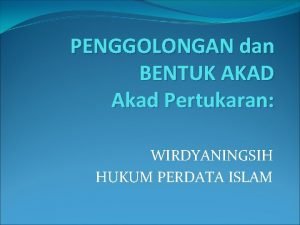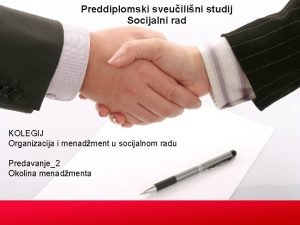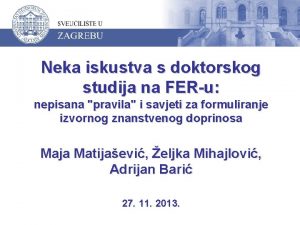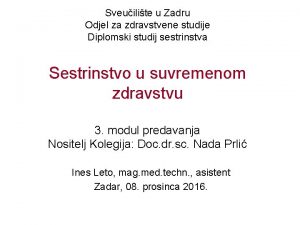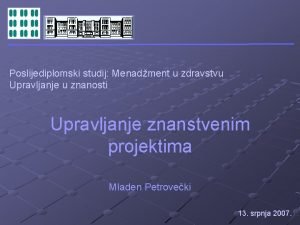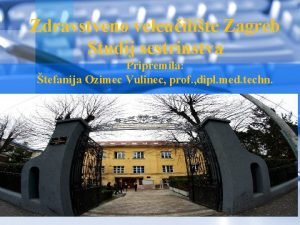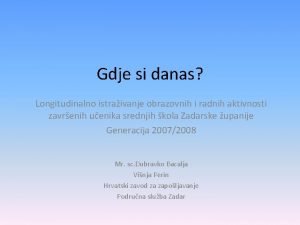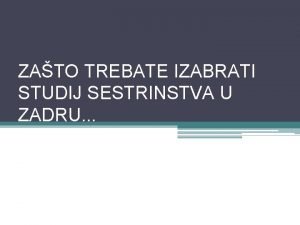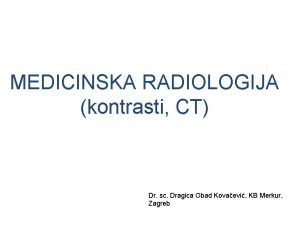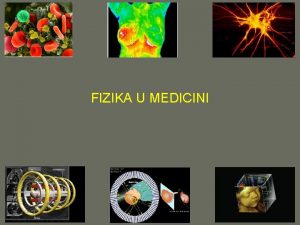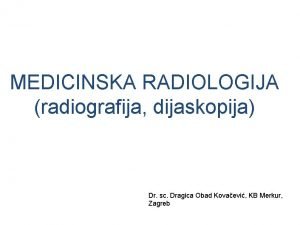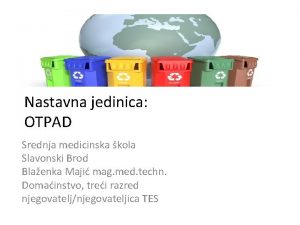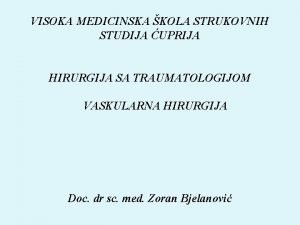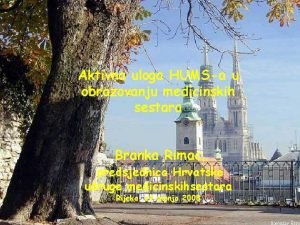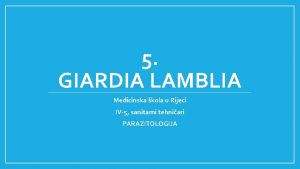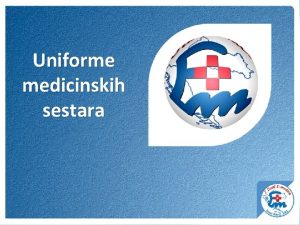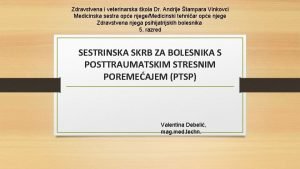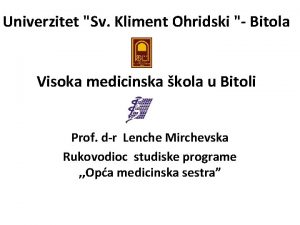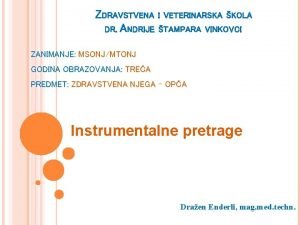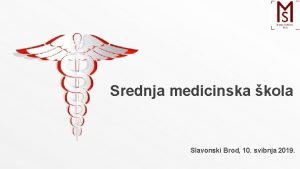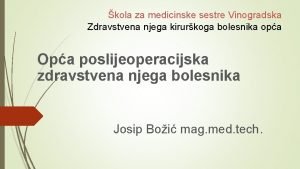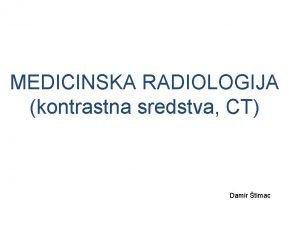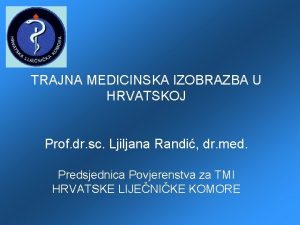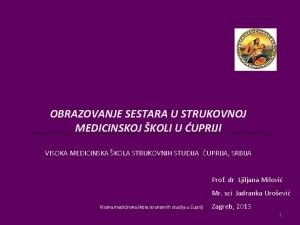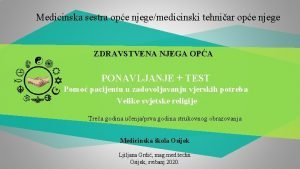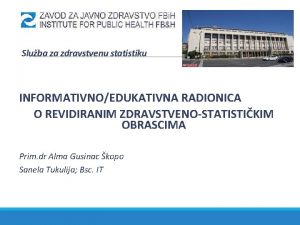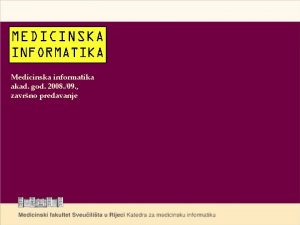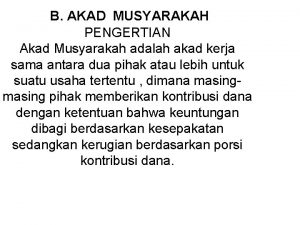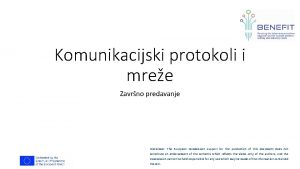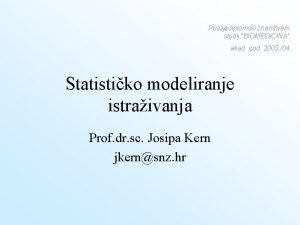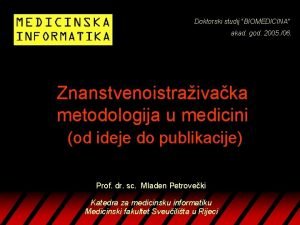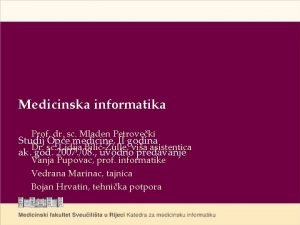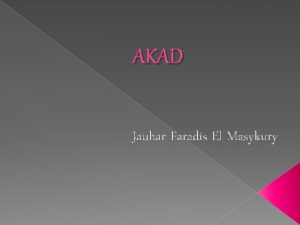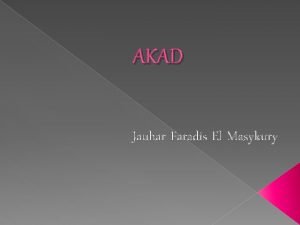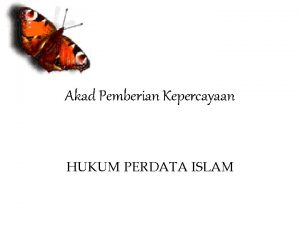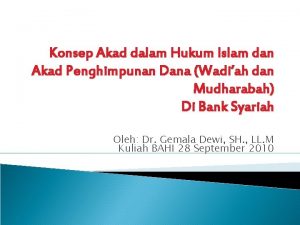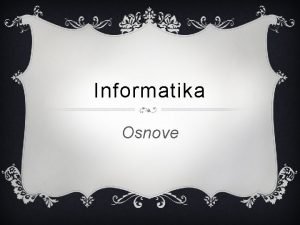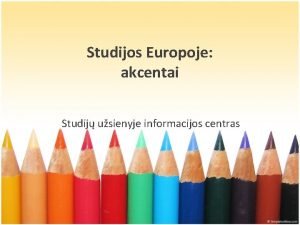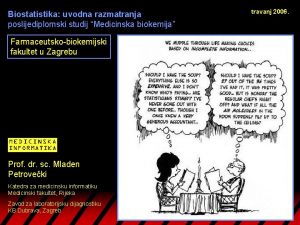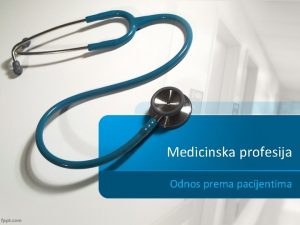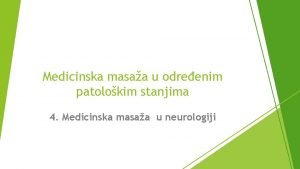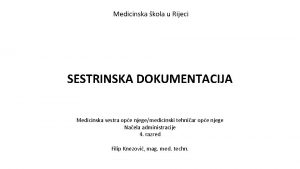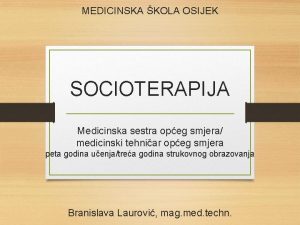Zavrno predavanje Medicinska informatika studij medicine akad god





























- Slides: 29

Završno predavanje Medicinska informatika, studij medicine, akad. god. 2003. /04. , završno predavanje

Povezivanje… http: //www. cs. bell-labs. com/who/ches/map/

…povezivanje… http: //www. lumeta. com/

…i razdvajanje http: //www. unik. no/~robert/hifi/dvd/world. html

Globalizacija Oregon Health & Science University 2003 IMIA Working Group on Education meeting, April 23 -25, 2003 Portland, USA “Teach Globally, Learn Locally: Innovations in Health and Biomedical Informatics Education in the 21 st Century” The goals … biomedical informatics education… planning for the development of the IMIA “virtual university” that will enable…

E-časopisi

E. Coiera, 1998. (TIR) The computer, the telephone, the Web, video – these, and all that is still to come, are unquestionably powerful tools. Used badly, they waste time and money, and dehumanise our interactions with each other. Used well, guided by a clear understanding of basic informatics principles, they are neither to be feared, loved nor loathed. They are simply to be used. In the next century, the study of informatics will become as fundamental to the practice of medicine as anatomy has been to the last. http: //www. informatics-review. com/thoughts/skills. html#Ten essential clinical informatics skills

Obrazovanje (medicinari) u Kako rabiti digitalnu znanost? (VJEŠTINE) u Što jest digitalna znanost? (ZNANJE) NASTAVNIK PREDAVAČ VODITELJ KOORDINATOR

10 vještina (E. Coiera) Clinicians should be able to: 1. Understand the dynamic and uncertain nature of medical knowledge and know how to keep personal knowledge and skills up-to-date 2. Search for and assess knowledge according to the statistical basis of scientific evidence 3. Understand some of the logical and statistical models of the diagnostic process 4. Interpret uncertain clinical data and deal with artefact and error 5. Analyse and structure clinical decisions in terms of risks and benefits 6. Adapt and apply clinical knowledge to the individual circumstances of patients 7. Access, assess, select and apply a treatment guideline; adapt it to local circumstances; and communicate and record variations in treatment plan and outcome 8. Structure and record clinical data in a form appropriate for the immediate clinical task, for communication with colleagues, or for epidemiological purposes 9. Select and utilize the most appropriate communication method for a given task (eg, face-to-face conversation, telephone, e-mail, video, voice-mail, letter) 10. Structure and communicate messages in a manner most suited to the recipient, task and chosen communication medium. http: //www. informatics-review. com/thoughts/skills. html#Ten essential clinical informatics skills

E-udžbenici, besplatni http: //bcs. whfreeman. com/biochem 5/

E-udžbenici, $ http: //www. harrisonsonline. com/

Izravno učenje s Interneta http: //www. diagnosticimaging. com/cme/articles/019. pdf


…sa testom znanja http: //www. mhsource. com/diagnostic/

Izravno (on-line). . . http: //bmj. com/cgi/content/full/323/7304/75 http: //www. riskscore. org. uk/

Simulacije… The Eagle Patient Simulator is a state-of-the-art realistic, hands-on simulator of the anesthetized or critically ill patient. A "hands-on” simulator is one in which the clinical environment and the patient are represented as real physical objects. A specially instrumented patient mannequin stands in for the patient, and real clinical equipment is used to make up the work environment. The modern anesthesia simulator was invented here at Stanford University in 1986 by a group led by David M. Gaba, M. D. , Associate Professor of Anesthesia.

The Eagle Patient Simulator (2001. ) Similarly, the simulator comes with over twenty abnormal "events" which can be triggered. These include things like, "hypoxemia", "malignant hyperthermia", "anaphylaxis", "myocardial ischemia". For each event there a variety of settings possible, governing how it is triggered, how severe it is and how quickly it will come on, and the relative intensity of the various possible manifestations. . Once the event's characteristics are tailored, it can be saved away under a new name. This enables instructors to create huge libraries of variants of the standard events. Up to three abnormal events can be running simultaneously. Thus, when different patients can be used, with hundreds of different events or their variants, there is nearly an infinite ability to replicate simple or challenging clinical situations. The simulator software provides other nice features. For example, Snap and Restore allows one to capture a scenario at any point in time and save it under a name. Thus, one can come back to that exact point at any time, picking up the simulation exactly where it left off. http: //pkpd. icon. palo-alto. med. va. gov/simulator/sim. htm

memed. medri. hr

http: //www. cmj. hr/index. php? D=/44/1/69

E-tromboza! u e-Thrombosis, a new threat for the 21 st century u The risk of developing life-threatening blood clots from sitting for long periods at a computer was revealed today in a case report from New Zealand. A young man who spent up to 18 hours a day sitting at his computer nearly died after developing a massive blood clot that formed in his leg veins, broke off and travelled to his lungs (pulmonary embolism). TIR, Vol. 6 No. 7

Studentski seminari u dobro, zanimljive informacije u malo tema van časopisa koje smo mi ponudili u najbolja: 4. skupina u opća zapažanja – gledati publiku tijekom izlaganja – čitanje vs. govor – pokazati na tekstu/slici što se govori – brzina – umjerena; paziti na vrijeme!

Studentski seminari u prikazi na računalu: – količina sadržaja (vrijeme na raspolaganju) – izradba “na brzinu” – preslika izvornog teksta – loše! – važno znati i razumijeti sadržaj, poznavati sve izraze, kratice i tumačenja – jako bitno: hrvatski književni jezik! – animacije

Studentski seminari u početak – “oprostite na puno teksta…” – “ja, nažalost, nisam…” – “bit ću kratak…” u završetak, zadnja rečenica, pitanje – “i to je to” u zanimanja za to što se radi

Ispit: gradivo u vježbe i seminari u Đuro Deželić Medicinska informatika HDMI, Zagreb, 1997. u Mladen Petrovečki i sur. Dopunski tekstovi mrežne stranice Katedre

Dopunsko gradivo u Degoulet P, Fieschi M. Introduction to Clinical Informatics Springer, 1997. u Van Bemmel JH, Musen MA. Handbook of Medical Informatics Springer, 1997. http: //www. mieur. nl/mihandbook/r_3_2/handbook/home. htm

Medicinska informatika http: //mi. medri. hr/ lbilicz@medri. hr Studenti se primaju utorkom i četvrtkom od 14 -16 sati, ako drukčije navedeno na oglasnoj ploči!

Ispit u pismeni: – test, 22 pitanja, 45 min – primjer testa na mrežnim stranicama u usmeni: – 5 pitanja – objavljena na mrežnim stranicama

Posebnost 2003. /04. 1. ne trebate ostavljati indeks 24 h prije ispita – morate ga imati sa sobom na ispitu 2. ocjena vrijedi samo za ispit u ponedjeljak, 14. lipnja 2004. , 15 h, predavaonica P 2, za sve studente osim: 3. “parcijala” – samo za ispit u subotu, 3. srpnja 2004. , 10 h, predavaonica P 2 4. ispitu moraju pristupiti svi studenti

Hvala na suradnji, uspješno polaganje ispita! POTPISI rezultati za generaciju 2003. /04. u pripremi
 Akad pertukaran adalah
Akad pertukaran adalah Izvanredni studij socijalnog rada zagreb
Izvanredni studij socijalnog rada zagreb Fer doktorski
Fer doktorski Diplomski studij sestrinstva zadar
Diplomski studij sestrinstva zadar Odjel za zdravstvene studije zadar
Odjel za zdravstvene studije zadar Poslijediplomski studij menadžment u zdravstvu
Poslijediplomski studij menadžment u zdravstvu štefanija ozimec vulinec
štefanija ozimec vulinec Strucni studij javne uprave
Strucni studij javne uprave Stručni i sveučilišni studij
Stručni i sveučilišni studij Studij sestrinstva zadar
Studij sestrinstva zadar Medicinska radiologija
Medicinska radiologija Primena fizike u medicini i tehnologiji
Primena fizike u medicini i tehnologiji Medicinska sestra vaspitac predmeti po godinama
Medicinska sestra vaspitac predmeti po godinama Dragica obad kovačević
Dragica obad kovačević Srednja medicinska škola slavonski brod
Srednja medicinska škola slavonski brod Visa medicinska skola cuprija
Visa medicinska skola cuprija Privatna visa medicinska skola
Privatna visa medicinska skola Medicinska škola rijeka
Medicinska škola rijeka Uniforme za medicinske sestre
Uniforme za medicinske sestre Medicinska škola vinkovci
Medicinska škola vinkovci Dijaskopija jednjaka
Dijaskopija jednjaka Visoka medicinska skola bitola predmeti
Visoka medicinska skola bitola predmeti Medicinska škola vinkovci
Medicinska škola vinkovci Smš sb
Smš sb škola za medicinske sestre vinogradska
škola za medicinske sestre vinogradska Kontrast za ct
Kontrast za ct Hlk bodovi
Hlk bodovi Visoka medicinska skola cuprija
Visoka medicinska skola cuprija Medicinska sestra opće njege
Medicinska sestra opće njege Osnovna medicinska dokumentacija
Osnovna medicinska dokumentacija
